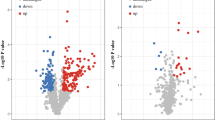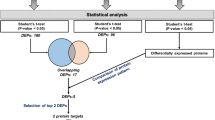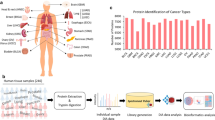Abstract
Backgrounds
Triple negative breast cancer (TNBC) is a heterogeneous disease with more aggressive clinical courses than other subtypes of breast cancer. In this study, we performed high-resolution mass spectrometry-based quantitative proteomics with TNBC clinical tissue specimens to explore the early and sensitive diagnostic signatures and potential therapeutic targets for TNBC patients.
Methods
We performed an iTRAQ labeling coupled LC–MS/MS approach to explore the global proteome in tumor tissues and corresponding para-tumor tissues from 24 patients with grade I-II and grade III primary TNBC. Relative peptide quantification and protein identification were performed by Proteome Discoverer™ software with Mascot search engine. Differentially expressed proteins were analyzed by bioinformatic analyses, including GO function classification annotation and KEGG enrichment analysis. Pathway analyses for protein–protein interactions and upstream regulations of differentially expressed candidates were performed by Ingenuity Pathway Analysis (IPA) software.
Results
Totally, 5401 unique proteins were identified and quantified in different stage of TNBCs. 845 proteins were changed in patients with grade I or II TNBC, among which 304 were up-regulated and 541 were down-regulated. Meanwhile, for patients with grade III TNBC, 358 proteins were increased and 651 proteins were decreased. Comparing to para-cancerous tissues, various signaling pathways and metabolic processes, including PPAR pathways, PI3K-Akt pathway, one-carbon metabolism, amino acid synthesis, and lipid metabolism were activated in TNBC cancer tissues. Death receptor signaling was significantly activated in grade I-II TNBCs, however, remarkably inhibited in grade III TNBCs. Western blot experiments were conducted to validate expression levels of CYCS, HMGA1 and XIAP with samples from individual patients.
Conclusions
Overall, our proteomic data presented precise quantification of potential signatures, signaling pathways, regulatory networks, and characteristic differences in each clinicopathological subgroup. The proteome provides complementary information for TNBC accurate subtype classification and therapeutic targets research.






Similar content being viewed by others
Data Availability
Raw proteomics data have been uploaded to the ProteomeXchange Consortium via the PRIDE partner repository with the subproject ID PXD020867 (https://www.ebi.ac.uk/pride/archive/projects/PXD020867). All data generated or analyzed during this study are included in this article (and its supplementary information files).
Abbreviations
- TNBC:
-
Triple negative breast cancer
- ER:
-
Estrogen receptor
- PR:
-
Progesterone receptor
- HER2:
-
Human epidermal growth factor receptor 2
- LC/MS:
-
Liquid chromatography-mass spectrometry
- IDA:
-
Information-dependent acquisition
- GO:
-
Gene ontology
- IPA:
-
Ingenuity Pathway Analysis
- DEP:
-
Differential expressed protein
- PPAR:
-
Peroxisome proliferator-activated receptor
- CYCS:
-
Cytochrome c
- HMGA1:
-
High mobility group protein A1
- ERO1A:
-
ERO1-like protein alpha
- TNF:
-
Tumor necrosis factor
- FADD:
-
Fas-associating protein with death domain
References
Foulkes WD, Smith IE, Reis JS (2010) Triple-negative breast cancer. N Engl J Med 363(20):1938–1948
Carey L, Winer E, Viale G, Cameron D, Gianni L (2010) Triple-negative breast cancer: disease entity or title of convenience? Nature Reviews Clinical Oncology 7(12):683–692
Bianchini G, Balko JM, Mayer IA, Sanders ME, Gianni L (2016) Triple-negative breast cancer: challenges and opportunities of a heterogeneous disease. Nature Reviews Clinical Oncology 13(11):674–690
Mertins P, Mani DR, Ruggles KV, Gillette MA, Clauser KR, Wang P et al (2016) Proteogenomics connects somatic mutations to signalling in breast cancer. Nature 534(7605):55–62
Huang KL, Li S, Mertins P, Cao S, Gunawardena HP, Ruggles KV et al (2017) Proteogenomic integration reveals therapeutic targets in breast cancer xenografts. Nat Commun 8:14864
Johansson HJ, Socciarelli F, Vacanti NM, Haugen MH, Zhu Y, Siavelis I et al (2019) Breast cancer quantitative proteome and proteogenomic landscape. Nat Commun 10(1):1600
Jiang YZ, Ma D, Suo C, Shi J, Xue M, Hu X et al (2019) Genomic and transcriptomic landscape of triple-negative breast cancers: subtypes and treatment strategies. Cancer Cell 35(3):428–440.e5
Weigelt B, Pusztai L, Ashworth A, Reis-Filho JS (2011) Challenges translating breast cancer gene signatures into the clinic. Nat Rev Clin Oncol 9(1):58–64
Liu NQ, Stingl C, Look MP, Smid M, Braakman RB, De Marchi T et al (2014) Comparative proteome analysis revealing an 11-protein signature for aggressive triple-negative breast cancer. J Natl Cancer Inst 106(2):djt376
Lawrence RT, Perez EM, Hernández D, Miller CP, Haas KM, Irie HY et al (2015) The proteomic landscape of triple-negative breast cancer. Cell Rep 11(4):630–644
Wiese S, Reidegeld KA, Meyer HE, Warscheid B (2007) Protein labeling by iTRAQ: a new tool for quantitative mass spectrometry in proteome research. Proteomics 7(3):340–350
Köcher T, Pichler P, Schutzbier M, Stingl C, Kaul A, Teucher N et al (2009) High precision quantitative proteomics using iTRAQ on an LTQ Orbitrap: a new mass spectrometric method combining the benefits of all. J Proteome Res 8(10):4743–4752
Perez-Riverol Y, Csordas A, Bai JW, Bernal-Llinares M, Hewapathirana S, Kundu DJ et al (2019) The PRIDE database and related tools and resources in 2019: improving support for quantification data. Nucleic Acids Res 47(D1):D442–D450
Di Cosimo S, Baselga J (2010) Management of breast cancer with targeted agents: importance of heterogeneity. Nat Rev Clin Oncol 7(3):139–147
Mayer IA, Abramson VG, Lehmann BD, Pietenpol JA (2014) New strategies for triple-negative breast cancer–deciphering the heterogeneity. Clin Cancer Res 20(4):782–790
Torres-Adorno AM, Lee J, Kogawa T, Ordentlich P, Tripathy D, Lim B et al (2017) Histone deacetylase inhibitor enhances the efficacy of MEK inhibitor through NOXA-mediated MCL1 degradation in triple-negative and inflammatory breast cancer. Clin Cancer Res 23(16):4780–4792
Akbani R, Ng PK, Werner HM, Shahmoradgoli M, Zhang F, Ju Z et al (2014) A pan-cancer proteomic perspective on The Cancer Genome Atlas. Nat Commun 5:3887
Tyanova S, Albrechtsen R, Kronqvist P, Cox J, Mann M, Geiger T (2016) Proteomic maps of breast cancer subtypes. Nat Commun 7:10259
Michalik L, Wahli W (2008) PPARs mediate lipid signaling in inflammation and cancer. PPAR Res 2008:134059
Wahli W, Michalik L (2012) PPARs at the crossroads of lipid signaling and inflammation. Trends Endocrinol Metab 23(7):351–363
Doan TB, Graham JD, Clarke CL (2017) Emerging functional roles of nuclear receptors in breast cancer. J Mol Endocrinol 58(3):R169–R190
Fuchs Y, Steller H (2011) Programmed cell death in animal development and disease. Cell 147(4):742–758
Peter ME, Krammer PH (2003) The CD95(APO-1/Fas) DISC and beyond. Cell Death Differ 10(1):26–35
Hughes MA, Powley IR, Jukes-Jones R, Horn S, Feoktistova M, Fairall L et al (2016) Co-operative and hierarchical binding of c-FLIP and caspase-8: a unified model defines how c-FLIP isoforms differentially control cell fate. Mol Cell 61(6):834–849
Acknowledgements
We sincerely appreciate Guoquan Yan for his expert help in the quantitative proteomics experiment, and Dr. Yang Zhang for his technical assistance and insightful comments.
Funding
This work was supported by the Natural Science Foundation of China (81802766), the National Key Research and Development Program of China (2018YFA0507501, 2017YFA0505001), the China Postdoctoral Science Foundation (2017M621347) and the Joint Funds for the Innovation of Science and Technology of Fujian province (2017Y9033).
Author information
Authors and Affiliations
Contributions
LY, FF, WC, YP and SH conceived and designed the experiments. LL, HA, XJ, JM and GR performed the experiments. LL, WZ and YL analyzed the data. LY and LL wrote the manuscript. All authors contributed toward data analysis, drafting and critically revising the paper, gave final approval of the version to be published, and agreed to be accountable for all aspects of the work.
Corresponding authors
Ethics declarations
Conflict of interest
The authors declare that they have no competing interests.
Ethics approval
This study and consent procedure were approved by the Ethics Committee of Fujian Medical University Union Hospital (Fujian, China). All the participants provided their written informed consent to be included in the study.
Additional information
Publisher's Note
Springer Nature remains neutral with regard to jurisdictional claims in published maps and institutional affiliations.
Electronic supplementary material
Below is the link to the electronic supplementary material.
10549_2020_5916_MOESM1_ESM.tif
Supplementary file1 Fig. S1 Representative images of HE-stained sections were presented. (a) Histological images of tumor tissue and adjacent non-tumor tissue from different stage of TNBCs (original magnification ×100, scale bars, 200 μm). (b) Representative images from TNBC patients with stage III showed more tumor foci (yellow arrows). In the middle panel, lymphocytic infiltrations were detected surrounding tumor foci which were indicated by arrows. Neovascularization was shown in right panel to support the rapid growth of tumor foci. (TIF 6524 kb)
10549_2020_5916_MOESM2_ESM.tif
Supplementary file2 Fig. S2 IHC staining for ER, PR and HER2 in tumor tissues (Left panel: magnification × 100; scale bars, 200 μm; Right panel: magnification × 200, scale bars, 100 μm). (TIF 16104 kb)
10549_2020_5916_MOESM3_ESM.tif
Supplementary file3 Fig. S3 Overview of proteomics dataset of different stage TNBCs and quality control for the mass spectrometry. a Scatter plots for replicate proteome profiling of 24 paired tumor and para-tumor samples from TNBC patients. b Venn diagram comparing the number of identified proteins for the three replicates and their relationship. c Venn diagram comparing the number of differential expressed proteins quantified in different stage of TNBC tissues. (TIF 980 kb)
10549_2020_5916_MOESM4_ESM.tif
Supplementary file4 Fig. S4. Functional analyses of changed proteins from tumor tissues with different stages. a Classification of KOG function for significant changed proteins which were aligned to the KOG database to predict and categorize possible functions. Proteins were divided into 20 subcategories and represented by different colors. b Activating (z-sore>2) and inhibiting (z-sore<-2) of upstream transcription factors were exhibited when comparing grade III tumor tissues with grade I-II tumor tissues. The red nodes and the green nodes in the outer ring represented the up-regulated and down-regulated proteins respectively. The inner ring theme colors of orange and blue, with orange indicating “activated” and blue reflecting “inhibited”. The inset image showed the prediction legend. (TIF 2068 kb)
10549_2020_5916_MOESM5_ESM.tif
Supplementary file5 Fig. S5. IHC staining were performed to examine the expression of CD4 and CD8 (Left panel: magnification × 100; Right panel: magnification × 200) (TIF 5416 kb)
10549_2020_5916_MOESM6_ESM.tif
Supplementary file6 Fig. S6. Networks developed by IPA integrated DEPs when compared tumor with para-tumor tissues from TNBC patients with grade I-II a and from TNBC patients with grade III b. Generated networks, which were ordered by score meaning significances, were associated to diseases and functions according to both up- and down-regulated identifiers. IPA top two score networks were presented in which gene products were represented as nodes and direct biological relationships between two nodes as a line. The red nodes were the up-regulated proteins while the green nodes were the reduced ones (TIF 1305 kb)
Rights and permissions
About this article
Cite this article
Lin, Y., Lin, L., Fu, F. et al. Quantitative proteomics reveals stage-specific protein regulation of triple negative breast cancer. Breast Cancer Res Treat 185, 39–52 (2021). https://doi.org/10.1007/s10549-020-05916-8
Received:
Accepted:
Published:
Issue Date:
DOI: https://doi.org/10.1007/s10549-020-05916-8




